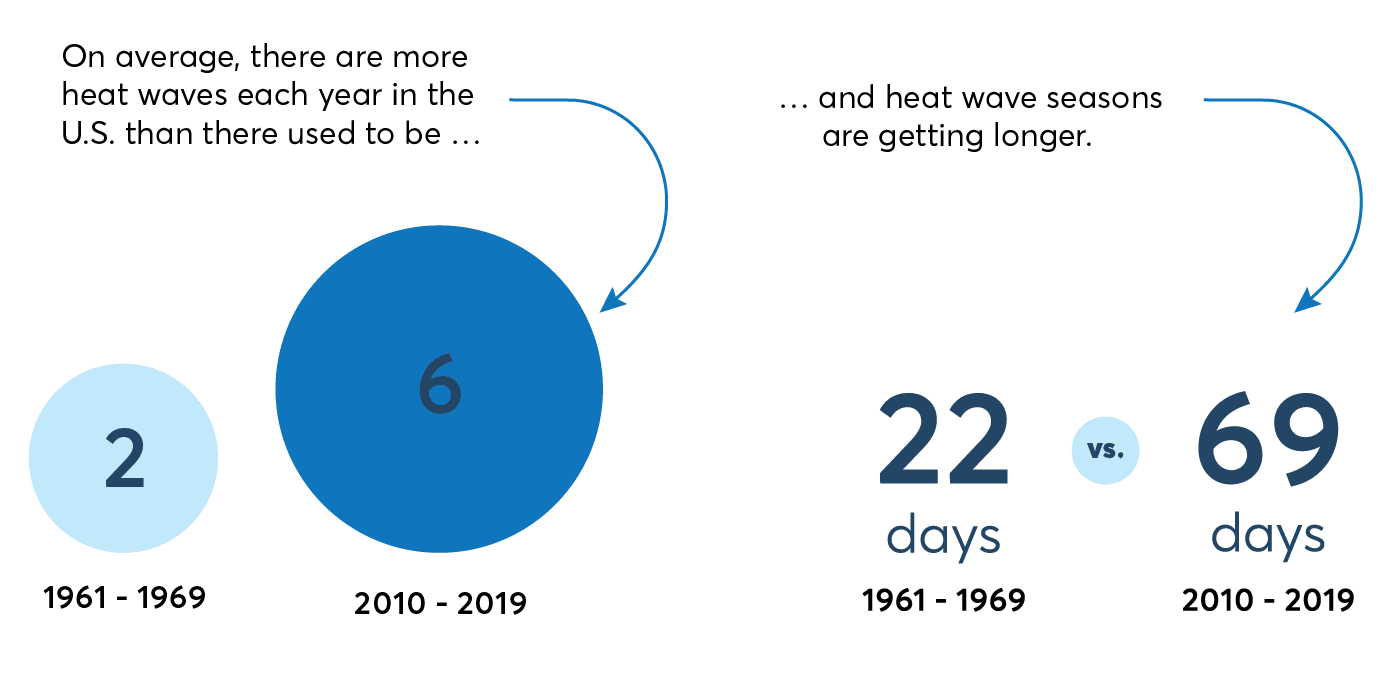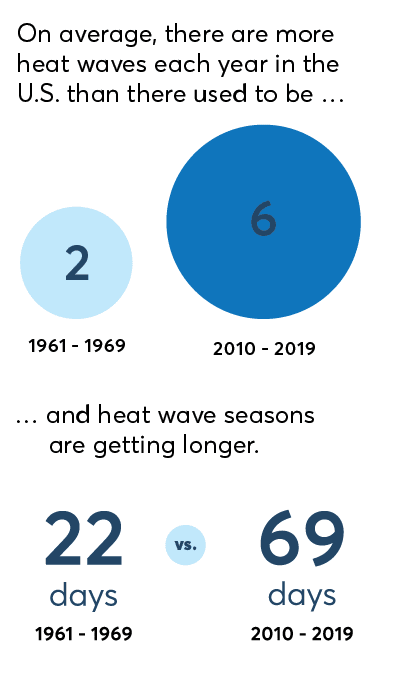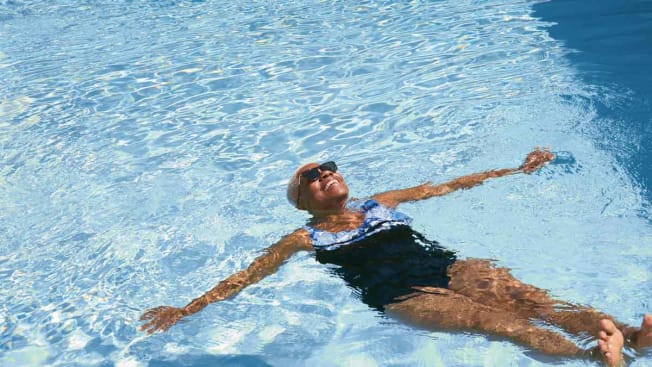CR's Ultimate Heat Survival Guide
With temperatures rising, we’ve gathered the best ways to stay comfortable and safe—both inside and out—even on scorching hot days

Unless you’ve been living in a deep, cool cave somewhere, you’re probably aware that our world—or at least many parts of it—is getting hotter. In the U.S., little has been more emblematic of these rising temperatures than June 2021’s string of 110° F days in the Pacific Northwest, where temperatures are typically in the 70s at that time of year. Almost 200 people perished, and there’s some suggestion that the number was grossly underreported.
Nationally and globally, the drumbeat of high-heat advisories is quickening. “It’s definitive that we are already seeing an increase in the frequency, intensity, and duration of heat waves,” says Kristie L. Ebi, PhD, MPH, a climate researcher and professor at the Center for Health and the Global Environment at the University of Washington in Seattle. “The projections are that this will continue across the U.S.”
At this point, heat—often in tandem with the high humidity that can increase the risk of dangerous conditions such as heatstroke—kills up to 1,300 Americans annually. It sickens tens of thousands more, often the very young, the very old, the already ill, and the poor.


Keep Your Home Comfortable
A cool room may be the best place to be during heat waves—especially during the middle of the day, when temperatures tend to be at their highest. Some simple actions, like swapping heat-emitting incandescent bulbs for LEDs or CFLs and routinely cleaning or replacing your air conditioner filters, can help you stay chill without ramping up your energy use (and bills). If you can’t cool your home sufficiently, and especially if you’re sweating profusely and/or feeling confused, try to find a nearby cooling center, which can provide a much-needed respite from the heat, by calling your local health department or area officials.
Stop Heat From Building Up
Seal hot air out. To keep sweltering outdoor air from making its way into your home, caulk and weather strip doors and windows. Unsure when your attic insulation was last replaced or whether it’s adequate? A certified or licensed contractor can evaluate it.
Block the sun. Close blinds, drapes, and shades, especially when the sun is hitting them. “Doing so will minimize the intake of heat that you’d just have to get rid of later,” says Wendell Porter, PhD, senior lecturer emeritus in agricultural and biological engineering at the University of Florida in Gainesville. Stick-on reflective/solar-blocking window film or mesh solar window screens also cut heat and glare.
Be appliance wise. During the day’s heat, avoid running your clothes dryer or oven, and use the cold-water setting on your washing machine and the air-dry setting on your dishwasher. For cooking, a multi-cooker, microwave, and/or toaster oven won’t heat up the kitchen the way your oven will.
Consider bigger steps. Planting deciduous trees on the south side of your house provides shade in summer. Painting the exterior a light color will reflect heat instead of absorbing it. “Cool roof” coating materials can shed heat but are best in warmer climates, where you need less “heat gain” from the sun in the winter.
Try Low-Tech Cooling Tactics
Flip a fan on. Ceiling, portable, and window fans stir up breezes that speed sweat evaporation, which will help you feel cooler. A ceiling fan, for instance, can make the temperature feel up to 4° F chillier, the Department of Energy says. In the past, groups such as the World Health Organization have cautioned that electric fans can’t cool us adequately when temperatures are above 95° F. But research that was published in The Lancet Planetary Health in 2021 found that fans can offer relief 95 percent of the time when the temperature is between 98.6° F and 102.2° F. Window fans typically pull outside air in and circulate it, so they may be most effective at night.
Chill out at night. Natural, breathable bedding fabrics such as cotton and linen allow sweat to dissipate instead of locking it in the way synthetic fibers like polyester and nylon may. People who sleep hot might consider a mattress cooling pad or a mattress that retains less heat on hot nights. (See “Best Mattresses for Hot Sleepers From Consumer Reports’ Tests.”)
Optimize Your Air Conditioning
Position it properly. Place window units in north-facing or shaded windows. A unit pounded by the sun will have to work much harder to cool the room. Keep heat-emitting objects such as computers, TVs, and lamps out of the line of the unit’s airflow for the same reason.
Give it some TLC. Vacuum window unit filters every couple of weeks, wash the filters with warm water and soap at least every two months, and replace the filters when they’re worn. For a whole-house system, a licensed, certified air conditioner contractor can check it every year to make sure your air conditioner or heat pump system is running well.
Up your efficiency. To reduce your air conditioner usage and still stay comfortable, use fans at the same time. “Set the thermostat 1 or 2 degrees higher than you would otherwise with a fan on,” Porter says. “Each degree higher your A/C is set toward 78° F can save up to 4 percent on your energy costs.” A WiFi-enabled smart thermostat, which allows you to manage your central air conditioner via smartphone, may let you set different temperatures for different rooms and times of the day. Some newer WiFi-enabled window air conditioners can also be controlled by a smartphone or tablet.
Buy smart. Air conditioners with the Energy Star label are the most energy-wise and planet-friendly. Also, check for a high seasonal energy-efficiency rating (SEER), which tells you how efficient a central air conditioning system is. “Right now, the minimum rating is 14 SEER, and some go up to 21,” says Don Brandt, a recently retired HVAC sales engineer who spent 39 years at Trane Technologies. “The higher the rating, the more you’re likely to spend, but the better the unit is and the more you will save every year.”
Check air conditioning alternatives. Evaporative coolers, which are best for a dry climate, chill outdoor air before it’s directed into your home. Another option is an energy-efficient electric heat pump, which provides cool air in the summer and heat in winter. (See our heat pump brand reliability ratings and buying guide.)
Heat cramps: Marked by muscle spasms or pain and possible heavy sweating during intense physical activity. Stop, get to a cool place, and drink water or a beverage with electrolytes. Get medical help right away if you have heart problems, you’re on a low-sodium diet, or your cramps last longer than an hour.
Heat exhaustion: This can progress to heatstroke if not addressed. Signs may include heavy sweating; fatigue; weakness; a cold, clammy feeling; a pale appearance; a fast but weak pulse; nausea or vomiting; muscle cramps; a headache; and even fainting. Cease physical activity, get to a cool place, use a wet cloth or take a cool bath to lower body temperature, and sip water. Get medical help right away if you vomit or symptoms worsen or last longer than an hour.
Heatstroke: This can be fatal if not addressed, so call 911 ASAP in the case of confusion or agitation, fainting, and an inability to sweat. While awaiting help, rest in an air-conditioned room or get into a cool shower or bath. Don’t drink anything.
Take Smart Steps When You’re Outside
Whether you’re mowing the lawn or taking a power walk, be especially careful when being physically active during summer’s heat. “On very hot and humid days, your body’s ability to dissipate heat declines,” says Thomas A. Waters, MD, an emergency medicine physician at the Cleveland Clinic. “Don’t think you can just push through it.” Here’s what else the experts advise.
Avoid Hot Spots
Dress to cool. Loose, light, pale-colored clothing in breathable natural fibers like cotton and linen reflect heat instead of absorbing it and permit perspiration to evaporate, cooling you down. But for exercise or outdoor physical work in the heat, activewear that’s moisture-wicking (look for the term on clothing tags) is a good choice, says Mike Szymanski, director of education at the University of Connecticut’s Korey Stringer Institute in Storrs. The clothing has tiny capillarylike structures that pull sweat away from the skin to the fabric’s surface, cooling you down.
Prevent sunburn. A burn can increase the likelihood of dehydration and heat illness, so be diligent about protection, even on cloudy days. Seek shade between 10 or 11 a.m. and 5 p.m. when possible, Szymanski says. When you’re in the sun, wear a wide-brimmed hat and apply sunscreen with an SPF of at least 30; SPF 50 is better. Reapply every 2 hours and immediately after swimming or sweating.
Watch out for hot-car hazards. A car’s interior can heat up by 40° F within an hour, which can lead to dangerous or even deadly temperatures. Never leave anyone—especially children, who heat up far faster than adults, or pets—unattended inside a vehicle. Note: New cars from more than 15 manufacturers offer back seat occupancy reminders to reduce the risk that someone will be left in a vehicle on a hot day. These will become standard in most cars by 2025. Tesla’s Dog mode feature can keep the vehicle’s HVAC operating when it’s parked.
Harness the Cooling Power of Water
Drink up. Many of us don’t drink enough liquids when temperatures climb, and dehydration can increase the risk of dangerous heatstroke. “When you know heat is coming, you need to drink more than you think you need to,” says Wayne C. McCormick, MD, a physician at the University of Washington School of Medicine in Seattle. How much liquid you really need to take in depends on several factors, such as the weather, your activity level, and even the particular medications you’re taking.
But a cup of liquid every 90 minutes while you’re awake is a good start. If you’re outside in the heat working or exercising, ramp that up to a cup every half-hour. And if you aren’t urinating much (say, only every 4 hours), drink more. (Thirst isn’t really a reliable indicator because by the time you feel thirsty, you’re already somewhat dehydrated.)
Do you find it hard to hydrate as much as you probably should? Set alerts on your phone as a reminder. Sipping small amounts of liquids throughout the day, adding slices of citrus to a pitcher of water, and eating high-water foods such as fruit can also help you get enough liquid when the heat is on.
Alcohol is dehydrating, so keep consumption low when it’s hot. Caffeinated drinks can act as diuretics, but the impact isn’t significant enough to negate their hydrating power, says Gordon Giesbrecht, PhD, who runs the Laboratory for Exercise and Environmental Medicine at the University of Manitoba in Canada.
Try a better water bottle. Cool liquids feel good going down, and research shows that they can also help reduce your core body temperature. (Water that’s cool—50° F to 60° F—but not ice-cold is optimal for hydration, Szymanski says. But if super-cold beverages are what get you drinking enough liquids, go for it.) Heading out and about? Consider an insulated water bottle. Coleman, Hydro Flask, Klean Kanteen, Mira, and Stanley, among others, lay claim to keeping water refreshingly cool for at least 24 hours. For walking, hiking, and cycling, consider a hydration backpack, which has a water pouch and built-in straw to let you sip on the go.
Replace what sweat steals. If you’re seriously sweating through a heat wave, working outside, or exercising in the heat, snag something with electrolytes. These substances, which include sodium and potassium, are key to helping you to retain fluids and ward off dehydration while sweating. Sports drinks contain electrolytes, as do a number of hydration supplements—powders and tablets you can add to plain water. Hydration supplements you may see include Hydrant, LMNT, Nuun, and Skratch Labs Sport Hydration Drink Mix.

Photo: Getty Images Photo: Getty Images
Live the life aquatic. Taking a dip on a blistering-hot day delivers a double dose of relief. You feel cooler while swimming, and the evaporation of the water on your skin afterward will chill you further. Taking a cool bath or shower, wiping a damp cloth over your skin, spritzing yourself with cool water from a mister, or dunking your hat in water before putting it back on your head can lower your body temperature, too. For a quick chill, place a cool, damp cloth on pulse points like your armpits, forehead, and the back of your neck. This helps cool the blood circulating throughout your body. But be cautious about ice baths or using ice packs on pulse points for prolonged periods, says Waters at the Cleveland Clinic. You may cool yourself too much, causing you to shiver, which is your body’s attempt to generate heat—the opposite of what you want.
Excessive heat outlook: A heat wave is expected within three to seven days.
Excessive heat watch: Conditions are ripe for a heat wave within one to three days.
Heat advisory*: A maximum heat index temperature of 100° F or more, with nighttime temperatures of 75° F or higher, is expected within 12 hours and to last at least two days.
Excessive heat warning*: Extremely dangerous heat conditions. A maximum heat index temperature of 105° F or more for at least two days, with nighttime temps 75° F or higher expected within 12 hours.
Heat index: A measure of how hot it feels outside based on temperature and humidity. The latter is key: The more humid the air is, the longer it takes for sweat to evaporate and help you cool down.
Heat wave (or excessive or extreme heat): Abnormally hot (and possibly humid) weather for the time of year and area that typically lasts longer than two days.
*It’s important to prepare for these high heat situations, according to the National Weather Service, by ensuring, for instance, that you‘ll have a place to stay cool and access to plenty of liquids to help you stay hydrated. To get forecasts for your area, go to weather.gov and type in your ZIP code.
Editor’s Note: This article also appeared in the August 2022 issue of Consumer Reports magazine.
















